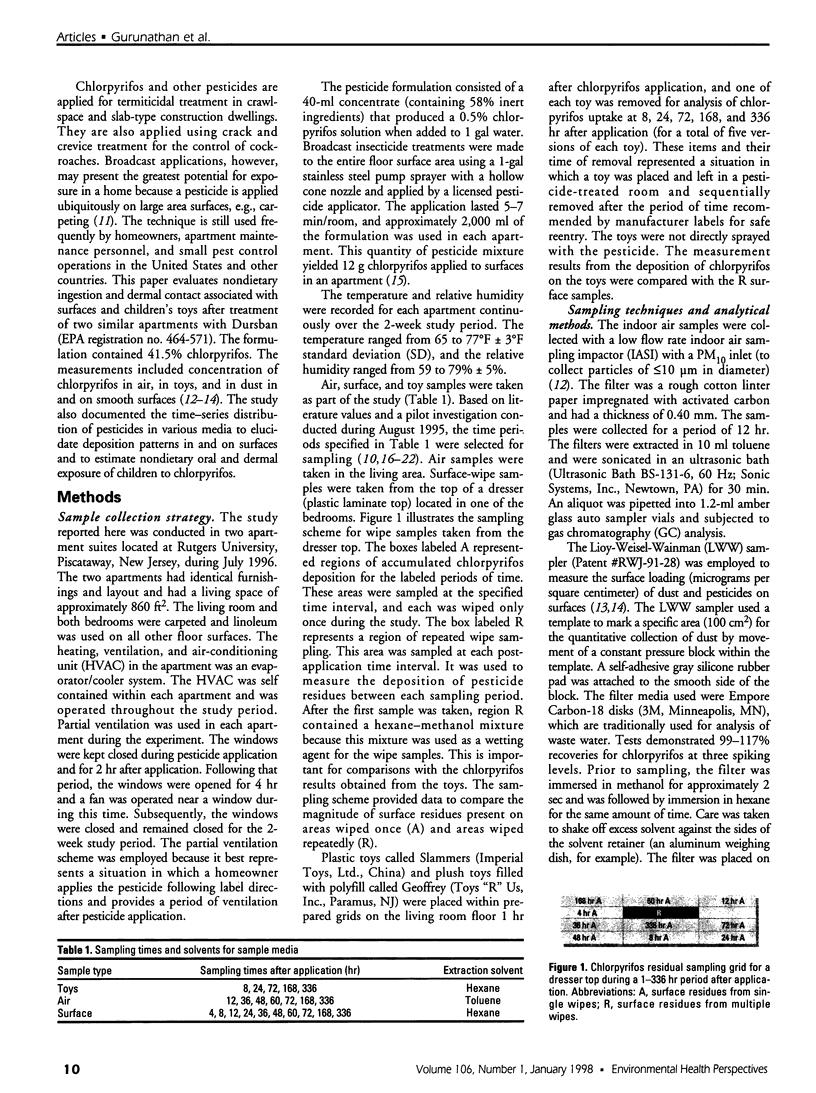Abstract
Quantitative examination of major pathways and routes of exposure to pesticides is essential for determining human risk. The current study was conducted in two apartments and examines the accumulation of the pesticide chlorpyrifos in childrens' toys after the time suggested for reentry after application. It has been established for the first time that a semivolatile pesticide will accumulate on and in toys and other sorbant surfaces in a home via a two-phase physical process that continues for at least 2 weeks postapplication. A summation of the above for a 3-6-year-old child yielded an estimated nondietary total dose of 208 microg/kg/day. Potential exposure from the inhalation pathway was negligible, while dermal and nondietary oral doses from playing with toys contributed to 39 and 61% of the total dose, respectively. If children with high frequency mouthing behavior are considered as candidates for acute exposure to chlorpyrifos residues, the estimated acute dose could be as high as 356 microg/kg/day. Routine reapplication of pesticides could lead to continued accumulation in toys and other sorbant surfaces, e.g., pillows, with large sorbant reservoirs, which can become a long-term source of exposure to a child. Estimates of a child's nondietary exposure to chlorpyrifos associated with toys and other sorbant surfaces for a period of 1 week following application appear to be of public health concern, and studies of actual childhood exposure from this pathway are warranted in the home environment. The above information should be used to determine if current procedures for postapplication reentry are sufficient and to evaluate the need for procedures to store frequently used household toys, pillows, and other sorbant objects during insecticidal application.
Full text
PDF







Images in this article
Selected References
These references are in PubMed. This may not be the complete list of references from this article.
- Currie K. L., McDonald E. C., Chung L. T., Higgs A. R. Concentrations of diazinon, chlorpyrifos, and bendiocarb after application in offices. Am Ind Hyg Assoc J. 1990 Jan;51(1):23–27. doi: 10.1080/15298669091369277. [DOI] [PubMed] [Google Scholar]
- Davis R. W., Kamble S. T. Distribution of sub-slab injected Dursban TC (chlorpyrifos) in a loamy sand soil when used for subterranean termite control. Bull Environ Contam Toxicol. 1992 Apr;48(4):585–591. doi: 10.1007/BF00199078. [DOI] [PubMed] [Google Scholar]
- Fenske R. A., Black K. G., Elkner K. P., Lee C. L., Methner M. M., Soto R. Potential exposure and health risks of infants following indoor residential pesticide applications. Am J Public Health. 1990 Jun;80(6):689–693. doi: 10.2105/ajph.80.6.689. [DOI] [PMC free article] [PubMed] [Google Scholar]
- Fenske R. A., Lu C. Determination of handwash removal efficiency: incomplete removal of the pesticide chlorpyrifos from skin by standard handwash techniques. Am Ind Hyg Assoc J. 1994 May;55(5):425–432. doi: 10.1080/15428119491018862. [DOI] [PubMed] [Google Scholar]
- Lewis R. G., Fortmann R. C., Camann D. E. Evaluation of methods for monitoring the potential exposure of small children to pesticides in the residential environment. Arch Environ Contam Toxicol. 1994 Jan;26(1):37–46. doi: 10.1007/BF00212792. [DOI] [PubMed] [Google Scholar]
- Lewis R. G., Fortmann R. C., Camann D. E. Evaluation of methods for monitoring the potential exposure of small children to pesticides in the residential environment. Arch Environ Contam Toxicol. 1994 Jan;26(1):37–46. doi: 10.1007/BF00212792. [DOI] [PubMed] [Google Scholar]
- Lioy P. J., Wainman T., Weisel C. A wipe sampler for the quantitative measurement of dust on smooth surfaces: laboratory performance studies. J Expo Anal Environ Epidemiol. 1993 Jul-Sep;3(3):315–330. [PubMed] [Google Scholar]
- Melnyk L. J., Berry M. R., Sheldon L. S. Dietary exposure from pesticide application on farms in the Agricultural Health Pilot Study. J Expo Anal Environ Epidemiol. 1997 Jan-Mar;7(1):61–80. [PubMed] [Google Scholar]
- Nolan R. J., Rick D. L., Freshour N. L., Saunders J. H. Chlorpyrifos: pharmacokinetics in human volunteers. Toxicol Appl Pharmacol. 1984 Mar 30;73(1):8–15. doi: 10.1016/0041-008x(84)90046-2. [DOI] [PubMed] [Google Scholar]
- Richter E. D., Kowalski M., Leventhal A., Grauer F., Marzouk J., Brenner S., Shkolnik I., Lerman S., Zahavi H., Bashari A. Illness and excretion of organophosphate metabolites four months after household pest extermination. Arch Environ Health. 1992 Mar-Apr;47(2):135–138. doi: 10.1080/00039896.1992.10118767. [DOI] [PubMed] [Google Scholar]
- Roinestad K. S., Louis J. B., Rosen J. D. Determination of pesticides in indoor air and dust. J AOAC Int. 1993 Sep-Oct;76(5):1121–1126. [PubMed] [Google Scholar]
- Savage E. P., Keefe T. J., Wheeler H. W., Mounce L., Helwic L., Applehans F., Goes E., Goes T., Mihlan G., Rench J. Household pesticide usage in the United States. Arch Environ Health. 1981 Nov-Dec;36(6):304–309. doi: 10.1080/00039896.1981.10667642. [DOI] [PubMed] [Google Scholar]
- Wester R. C., Maibach H. I. In vivo percutaneous absorption and decontamination of pesticides in humans. J Toxicol Environ Health. 1985;16(1):25–37. doi: 10.1080/15287398509530716. [DOI] [PubMed] [Google Scholar]
- Wright C. G., Jackson M. D. Insecticide movement following application to crevices in rooms. Arch Environ Contam Toxicol. 1976;4(4):492–500. doi: 10.1007/BF02221045. [DOI] [PubMed] [Google Scholar]
- Wright C. G., Jackson M. D. Insecticide residues in non-target areas of rooms after two methods of crack and crevice application. Bull Environ Contam Toxicol. 1975 Jan;13(1):123–128. doi: 10.1007/BF01684875. [DOI] [PubMed] [Google Scholar]
- Wright C. G., Leidy R. B. Chlorpyrifos residues in air after application to crevices in rooms. Bull Environ Contam Toxicol. 1978 Mar;19(3):340–344. doi: 10.1007/BF01685808. [DOI] [PubMed] [Google Scholar]
- Wright C. G., Leidy R. B., Dupree H. E., Jr Chlorpyrifos and diazinon detection on surfaces in dormitory rooms. Bull Environ Contam Toxicol. 1984 Mar;32(3):259–264. doi: 10.1007/BF01607495. [DOI] [PubMed] [Google Scholar]
- Wright C. G., Leidy R. B., Dupree H. E., Jr Insecticides in the ambient air of rooms following their application for control pests. Bull Environ Contam Toxicol. 1981 Apr;26(4):548–553. doi: 10.1007/BF01622135. [DOI] [PubMed] [Google Scholar]
- Wright C. G., Leidy R. B. Insecticide residues in the air of buildings and pest control vehicles. Bull Environ Contam Toxicol. 1980 Apr;24(4):582–589. doi: 10.1007/BF01608159. [DOI] [PubMed] [Google Scholar]








